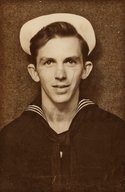
|

|
|
|
|
William was born "in the house" in Shreveport at 823 Stephenson Street, one of three sons to John Robertson and Louise White Robertson. As a child during the Depression, he recalls never "missing a meal. We were dressed properly most of the time. We were able to help other people," he reports. His father worked for a mill supply business, and drove a company car. Meanwhile, William "threw" newspapers. On Sunday the Robertsons attended Kings Highway Christian Church. At Byrd High School, William took three years of ROTC and graduated in 1940. At Louisiana Tech he majored in mechanical engineering, but left after a year to work for his father as a clerk. On January 25, 1943 he enlisted in the U.S. Navy. After boot camp in San Diego he was sent to diesel school at the University of Missouri, then to engine school at Packard Motor Car Company in Detroit. In Bremerton, Washington he was assigned to the USS Oyster Bay (AGP-6) a PT boat tender that he boarded on November 17, 1943. On January 2, 1944 he sailed to Brisbane, Australia, then on to New Guinea. The Oyster Bay, fitted with wood, engine, and ship fitter shops, was tasked with refueling and re-provisioning PT boats. William helped keep the vessel's four Fairbanks-Morris piston engines in order, and also serviced the PT boat engines. In addition to its own munitions, the ship also carried 100,000 gallons of high-octane fuel, torpedoes, and ammunition for PT boats. The tender was often under fire from Japanese planes. One bomb barely missed it, but the shrapnel wounded three men, one fatally. One Sunday morning in the fall of 1944, in action off the coast of the Philippines, he recalls his ship shooting down three kamikazes. In all, the Oyster Bay shot down seven of the Japanese attack planes. He also saw a kamikaze hit an American troop ship. "There were a lot of casualties in that," he remembers. William reports that he ate well aboard ship. He worked shifts of four hours on and four hours off when the ship was under way, but at anchor, put in a regular, eight-hour day. William sailed home in September of 1945 and was discharged in New Orleans on January 30, 1946. He would later join the reserves. On August 23, 1947 he married Paul Eleanor Hogan. (They would have two children, three grandchildren, and four great-grandchildren.) Returning to Louisiana Tech William earned an engineering degree in January of 1949. He was employed as a consulting engineer in Shreveport until the next summer, when he went to work for a surveying team for United Gas. A few months later he went to work for ArkLa Gas, but was recalled to the navy in summer of 1950. He sailed from San Francisco to Wonsan, Korea where he was assigned to a troop transport, USS Oglethorpe (AKA-100). He was second in charge of auxiliary equipment. He recalls the ship was carrying baseball bats and gloves and fishing gear for the PX. "I let the real boys go back to Korea," William quips. "That's basically what the reserves did, was relieve the full-timers on auxiliary duty. They didn't put me in harm's way," he says in describing his experience during the Korean War. In 1951 the ship sailed to the East Coast where it was dry docked in Norfolk, Virginia, for a complete overhaul. The Oglethorpe later sailed to Cuba, and then into the Mediterranean to participate in landing exercises for the marines. William, a petty officer, was discharged in Norfolk in January of 1952. He returned to Shreveport and his job with ArkLa Gas, where he worked in the measurement department, serving his last few years of his career as manager of the gas control department, He retired on July 31, 1988. |


